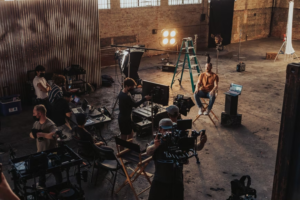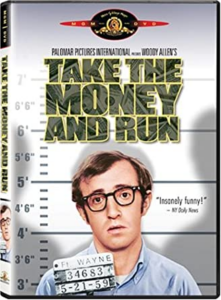When you’re planning out your next visual storytelling project, creating the treatment, or writing the actual script, you can refer to screenplay examples to guide you. These examples are fully written scripts that have been produced in the industry, and many developing screenwriters, directors, actors, and other filmmaking professionals read scripts to improve their skills.
Here, we cover some of the most instructive screenplay examples in each genre from some of the industry’s best writers and filmmakers.
Action/Adventure
The Dark Knight
This grim superhero film is not only one of director Christopher Nolan’s most notable films, but it also established one of the most intriguing villains, thanks to The Joker’s mixture of sinister and goofy characterization. Nolan and the other writers combine the comic book hero action with dark, crime-thriller choices for the protagonist, Bruce Wayne/Batman.
Ocean’s Eleven
With sequels and a spin-off film, this movie is a modern remake that follows a motley crew of skilled but quirky “professionals” in a fun, twisting heist adventure. It covers exposition in a skillful way to let the audience in on the plan without over-explaining, and readers and watchers alike invest quickly in the suave protagonist Danny Ocean as he leads his team through hiccups, improvisations, and terrific comedy riffs.
Die Hard
An oldie but a goodie, this Bruce Willis-lead film pits his rough-around-the-edges cop against a story-driving villain. With the tower as such a limited location, the action is contained and the tension of every scene carries over and builds, increasing suspense.
Other examples include:
- 300
- Aliens
- Inglorious Basterds
- The Bourne Ultimatum
- The Lord of the Rings: The Fellowship of the Ring
- Inside Out
- Lone Survivor
- Looper
- The Matrix
- Zombieland
Comedy
Juno
Diablo Cody’s Oscar-winning script weaves quirky teenage humor, quick flashbacks, and high emotional stakes to tell a story about family, love, and motherhood. It uses the conventions of romantic comedies, like boy and girl getting together at the end, as well as memorable lines, props, and characters that make it just plain funny.
(500) Days of Summer
This script uses a nonlinear structure that bounces around the 500 days of the protagonist Tom’s relationship with the hard-to-pin-down Summer and the funny, odd, and sad impacts on his life during and after their relationship.
Planes, Trains & Automobiles
This ’80s comedy uses the road movie structure and conventions to show a straight-laced family man who just wants to get home, Neal, played by Steve Martin, traveling with the bumbling and well-meaning Del, played by John Candy. With great physical comedy, comedic tension, and a lot of heart, this script is a great example of playing up the hilarity of two very different characters.
Other examples include:
- The Disaster Artist
- Election
- The Way, Way Back
- Bridesmaids
- The Hangover
- Hannah and Her Sisters
- Mean Girls
- Sideways
- Stranger than Fiction
- There’s Something About Mary
- When Harry Met Sally
Drama
Straight Outta Compton
This script is a terrific lesson in writing biopics, which are films based on the lives of real people. Read to see the themes and struggles represented in N.W.A’s music first-hand through the characters’ experiences as they create music, navigate the industry, and take their own paths.
The Truman Show
Combining a high concept with a down-to-earth protagonist, this script follows a man who is unknowingly living inside a reality TV show about his life. It features meta elements that set up a whole world within another world that resembles but isn’t quite the same as our own.
American Beauty
This script actually starts at the end of the story with the protagonist Lester telling us what would be the big reveal. Then, the story restarts at the beginning to show how Lester, his family, and his neighbors got there. In available versions of the script, you’ll notice early scenes covering more of the story’s end that were cut from the final film.
Other notable films include:
- Boogie Nights
- Forrest Gump
- Her
- Eternal Sunshine of the Spotless Mind
- Good Will Hunting
- Jerry Maguire
- Little Children
- Lost in Translation
- Up In the Air
- The Visitor
- Whiplash
Horror
Alien
This sci-fi/horror script uses a very minimal style, with short, punchy action lines that rarely go over one line long. The tension builds quickly, and we learn only what we need to know about each character and event of the film, creating hyper-focus on the terror.
The Conjuring
This script uses precise visuals, emphasizes sounds, and characterizes the house where the paranormal activity takes place to fully set the scene and create an eerie atmosphere from beginning to end. The formatting of the script itself, with the use of all caps sounds and actions as well as double dashes, creates a fast and tense pace that’s captured in the film itself.
Saw
Ticking clocks are great storytelling devices to amplify stakes and create intense pacing. Combined with the story itself, this script becomes a tense, horrifying lesson in creating obstacles, establishing vivid scenes, and keeping the audience guessing.
Other examples include:
- Let Me In
- A Quiet Place
- Us
- The Babadook
- Dawn of the Dead
- Final Destination
- Hereditary
- Insidious
- Jennifer’s Body
- The Omen
- The Sixth Sense
Thriller
Get Out
This Oscar-winning script by Jordan Peele blends comedy into this satirical thriller/horror story that sheds light on topics like race and class distinction. The visuals and the creation of “the sunken place” amplifies the unsettling nature of the white, upper-class setting and teases out the big, dangerous reveal of what the protagonist’s hosts are really up to.
Training Day
As a first-day-on-the-job movie meets hectic crime thriller, the script follows a clean-cut rookie detective riding with his new, more seasoned partner to learn the ropes. Slowly, small choices become large hurdles as this experienced cop tests the protagonist’s values and traps him in impossible situations, revealing that he’s in some bad business himself.
The Silence of the Lambs
Another Academy Award winner, this screenplay is a great lesson in adaptation writing. It follows an ambitious FBI trainee on a mission to catch a serial killer. This script features gripping interactions between Clarice and Hannibal Lecter, unnerving scenes with the killer on the loose, and a heart-pounding final sequence where Clarice meets her target face-to-face.
Other examples include:
- Flightplan
- Pulp Fiction
- Shutter Island
- Thriller
- The Departed
- The Girl on the Train
- Nightcrawler
- No Country for Old Men
- Prisoners
- Reservoir Dogs
- The Usual Suspects
What To Look For in Screenplay Examples
There are many lessons to learn from reading professional scripts and even comparing them to their filmed counterparts. Some of those lessons include:
- Inspiring character development: Look out for memorable introductions, clear goals, unique quirks, and life-like personalities. Use the hero’s journey structure to track your protagonist’s growth in the film.
- Realistic dialogue: What your characters say should feel natural to the world they’re in and to the audience watching. Find lines that bring out character personalities and show, not tell, the story. Consider also using localized slang or affectations to really bring people and places to life.
- Great scene description: Scripts can really show readers what they can expect from a scene’s setting by choosing unique locales, using precise language and visuals, and integrating thematic settings, objects, and colors.
- Well-executed plot points: Review both chronological and more complex or non-chronological structures that complement or improve the story. For example, Quentin Tarantino chose a structure of three interrelated stories for Pulp Fiction.
- Engaging scenes: Many script-to-film examples demonstrate how strong tension is built into scenes that keep readers and audiences on the edge of their seats. Scenes with clear obstacles and protagonist motivations keep eyes on the page and screen.
- Twists on genre conventions: Writers can subvert reader and audience expectations by making deliberate choices that go against the norm for a specific genre, such as in Cabin in the Woods. Others choose to blend genres together. Looney Tunes: Back in Action is a lesson in covering the whole gamut, including spy thriller, Western, sci-fi, and Indiana Jones-style adventure, not to mention the screwball comedy of the Looney Tunes.
Where To Find Screenplay Examples
There are many trusted sites that provide links to PDF files of scripts for you to download, read, and analyze. Some great sources include:
- The Script Lab
- The Internet Movie Script Database
- Simply Scripts
- The Black List’s “Go Into the Story”
- Daily Script
Reviewing scripts and produced films helps you develop as a filmmaker and visual storyteller. You can learn other techniques in cinematography, production design, and directing when comparing scripts to their final films. A professional filmmaking program like NFI’s Cinema Production Program can provide you the resources to study films and produce your own stories.














